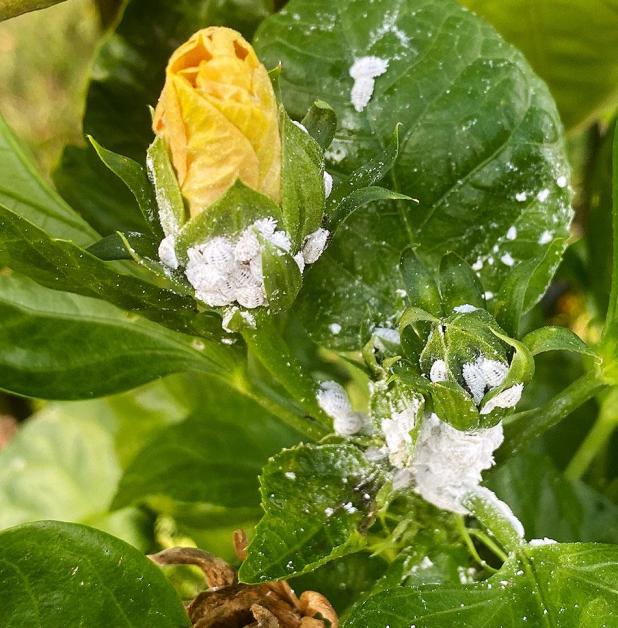
Mealybugs are often found on the leaves, stems and flower buds of your plants. If a plant is severely infested, consider pruning and removing heavily infested plant parts to prevent the spread of mealybugs to healthier sections of the plant. One indicator of the pests is the development of sooty mold on leaves of plants.
—LSU AgCenter/Heather Kirk-Ballard
Get It Growing: White stuff on plants caused by mealybugs
If you’ve noticed the presence of white, fluffy, cotton-like formations on your plants, chances are you’ve encountered one of the most common garden pests: mealybugs. These insects are often found on the leaves, stems and flower buds of your plants, leaving you wondering about the identity of this white substance.
Mealybugs are small, soft-bodied insects that belong to the family Pseudococcidae. They are common garden pests known for their ability to infest a wide range of plants both indoors and outdoors. Mealybugs are typically small, ranging from 1/16 to 1/4 inch (1.5 to 6 millimeters) in length, and they are covered with a white, waxy, cottony substance that gives them a distinctive appearance.
These pests are sap-sucking insects, meaning they feed on plant sap by piercing plant tissues with their long, needle-like mouthparts. Mealybugs primarily target the tender leaves, stems and flowers of plants. As they feed, they excrete a sugary substance called honeydew, which can attract other pests like ants and encourage the growth of sooty mold on plant surfaces.
Mealybugs reproduce rapidly, with female mealybugs capable of laying hundreds of eggs. This rapid reproduction can lead to large infestations if not controlled. There are many different types of mealybugs and not all reproduce and look the same, but their negative effects are very similar.
Mealybugs can cause damage by weakening plants, stunting growth, and even causing death to plants in severe infestations. They can infest a wide range of plants, but certain types are more susceptible than others. They tend to target plants with soft, tender growth and plants that produce a high amount of sap. Young leaves, stems and flower buds are particularly vulnerable.
Effective control measures include isolation of infested plants, manual removal, the use of insecticidal soaps or oils, biological controls such as natural predators and maintaining plant health to prevent infestations.
It helps to isolate infested plants. If you can do so, this will help prevent the spread of the bugs to nearby plants. You also can manually remove the insects with a soft brush or cotton swab dipped in 75% rubbing alcohol or soapy water to gently remove them from plant surfaces. This method can be intensive, and you should be persistent, as the insects tend to hide in crevices and leaf axils.
Some natural and effective pesticides include neem oil and insecticidal soaps. These are more eco-friendly options for controlling these pests.
Mix neem oil with water following the instructions on the product label and spray it on the affected plants. Neem oil disrupts the mealybugs’ feeding and reproduction. Insecticidal soap is another option for controlling mealybugs. Spray a solution of insecticidal soap and water on the infested plants, ensuring you cover the bugs thoroughly.
Another eco-friendly option is to use biological controls — natural predators like ladybugs, lacewings and parasitic wasps that feed on mealybugs. These beneficial insects can help keep mealybug populations in check. This can happen in nature, or you can look into online sources for purchase.
Two clear signs of a mealybug infestation are the presence of ants, which feed on the honeydew excreted by these insects, and the development of sooty mold on the honeydew produced by the mealybugs. You may notice plant decline before you notice either of these. The white, cottony substance is a dead giveaway.
The best defense is to ensure plants are healthy, making them more resilient to mealybug infestations. Ensure your plants receive proper care, including adequate water, appropriate fertilization and proper sunlight exposure. In addition, conduct regular inspections of your plants to catch mealybug infestations early. Early intervention is key to preventing large-scale infestations.
If a plant is severely infested, consider pruning and removing heavily infested plant parts to prevent the spread of mealybugs to healthier sections of the plant. Destroy or throw away the infested plant material to prevent further spread.
In severe infestations, you may consider using systemic insecticides. These are absorbed by the plant and can kill mealybugs when they feed on the plant’s sap. However, use these chemicals as a last resort, as they can harm beneficial insects and pollinators.
Remember to follow the instructions on any pesticide or treatment product you use and be patient and persistent in your efforts to control mealybugs, as it may take some time to completely eliminate them from your plants. Regular monitoring and early action are crucial to keeping mealybug populations in check. Controlling mealybugs can be challenging, but with the right strategies, you can effectively manage and reduce their populations in your garden or indoor plants.
